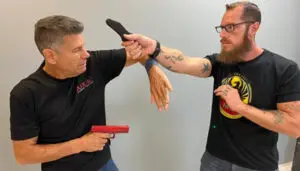Throughout the years I have spent training individuals in various fields (military, law enforcement, private security, and civilian settings), I have encountered a particular issue that is rarely discussed in training forums or instructor groups.
I am specifically referring to Improvisation vs. Planning in the development of firearms training courses. Which approach is better? Should we rely on planning, or should we embrace improvisation?
I do not intend to delve into formal education theories, as that is beyond my expertise. However, I believe it is essential to discuss this topic because we work in dynamic environments where we are constantly required to make real-time decisions. Unfortunately, this often forces us to choose between a structured plan or an adaptive approach.
Many professionals from military and law enforcement backgrounds see improvisation as impractical. However, my experience has shown that even rigid or pre-designed training structures have limitations, and we have all had to adapt at some point.
The purpose of this article is not to create controversy or provide a one-size-fits-all solution. Instead, I want to help fellow instructors who may be facing this dilemma and are unsure of the advantages and disadvantages of each approach. The key to success in training lies in knowing when and how to apply both methods effectively.
To clarify this, I have outlined the pros and cons of planned and improvised training courses in the table below:
Comparison Table: Planned vs. Improvised Training
| Training Approach | Pros ✅ | Cons ❌ |
|---|---|---|
| Improvised | – Encourages creativity. – Partial control of the situation. – Allows multiple ways to solve problems. – Trainees have input in the course. – Focuses on the trainee’s immediate needs. – Training dynamics develop naturally. – Results are reviewed and corrected as needed. – Problems are solved instantly. | – Partial loss of time. – Distorted perception of reality. – High risk of mistakes. – Development of unrealistic techniques. – Potential confusion among trainees – May appear unprofessional or unprepared. – Risk of losing control of the class. – Course may be emotion-driven rather than results-driven. – Trainees may not fully understand course objectives. – Risk of losing trainee’s interest. |
| Planned | – Strong control over subject matter and time. – In-depth knowledge of techniques . – Full control of the activity. – Avoids distractions from unexpected situations. – Trainees know what to expect. – Achieves objectives more effectively. – Allows comparison between planned vs. actual results. – No time wasted. | – Subject to a rigid structure. – Instructor or institution’s method prevails. – Training dynamics are imposed without adapting to real-time conditions. – Can create unnecessary stress for trainees. – Weak points may not be addressed due to time constraints. – Limits alternative solutions for specific issues. |
Finding the Right Balance
After reviewing this comparison, I might conclude that the best approach as firearms instructors is to combine the strengths of both training approaches. By integrating a certain level of flexibility, participation, and self-criticism while maintaining a structured teaching discipline, we can create an effective and adaptable training program.
Rafael Martin G./Firearms Instructor/IALEFI Member since 2002
rmartin67@gmail.com


